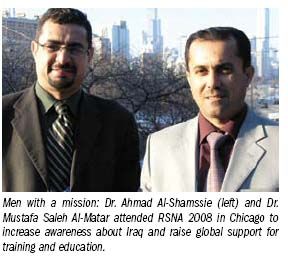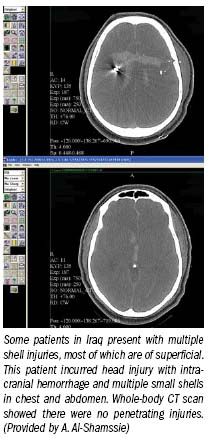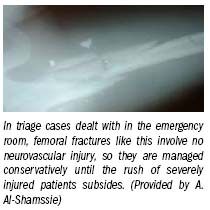Radiologists in war-torn country reach out for global support
For a man whose job is to care for sick people, Dr. Ahmad Al-Shamssie's journey to work is incredibly fraught with danger. His home is about 25 km from the Baghdad Medical City complex, where he is radiology chair at the teaching hospital.
For a man whose job is to care for sick people, Dr. Ahmad Al-Shamssie’s journey to work is incredibly fraught with danger. His home is about 25 km from the Baghdad Medical City complex, where he is radiology chair at the teaching hospital. He has to change his vehicle and his route to the hospital every day so that potential terrorists cannot target him easily. He never drives himself, and must change his driver frequently.
Many of Iraq’s 500 radiologists fear for their own safety on a daily basis. According to unpublished 2008 data gathered by Al-Shamssie, 2% of the 125 or so radiologists in Baghdad have been killed, 5% have been threatened, 25% have left the country, 30% have left the capital for safer places in the north and south, and 10% have switched jobs.
“Hospital staff must be aware of how to manage anger and difficult situations. Some hospitals in real hot spots have been occupied totally by militant groups,” he said. “If employees suspect something is wrong, they have to change their clothes, get rid of their IDs, and mix with the patients or their relatives.”
Al-Shamssie has received threatening letters. He was injured during an attack on him in June 2007, and his close friend and fellow Baghdad radiologist, Prof. Samir, was murdered the same month.
He realizes that the militants aim to dismantle the healthcare service, cause maximum chaos, and disrupt as many lives as possible, but he is determined to keep working.
“If we don’t continue, then we will end up with another Saddam [Hussein], or a corrupt system that could lead to another dictator. That’s the real issue,” he said during an exclusive interview with Diagnostic Imaging Europe at December’s RSNA meeting.

Dr. Mustafa Saleh Al-Matar, head of radiology at Basra Teaching Hospital, also perceives that his personal security is constantly under threat. In September 2007, he had to leave Iraq for security reasons and spent two months in the United Arab Emirates. Six months later, his close colleague, Prof. Khaled Naser Al-Miyahi, professor of neurosurgery at Basra Teaching Hospital, was assassinated. The neurosurgeon was kidnapped from his car by a group of armed men, and his tortured body was found the next day in the streets of Basra. There were no ransom demands.
Furthermore, the continuing tragedy for Iraqi radiologists is that they remain largely isolated from the rest of the world. They were isolated before the war because they had no access to the Internet. Now they are isolated due to visa restrictions and because the profession has little or no organizational structure and the training system is in tatters, according to Al-Shamssie.
Al-Shamssie retains some optimism, however. He has attended the past two RSNA meetings to inform international attendees about the situation in Iraq, canvass support and raise funds essential for improvements in education, and draw up a proposed plan of action for the American College of Radiology and RSNA to assist the rebuilding of radiology in Iraq. He believes academics in Iraq need more support because they will change society and have a positive impact. It is time for Iraq to rejoin the international community, and global exchange programs will allow qualified people to lead the country in a professional way, he said.
WORKING CONDITIONS
The Baghdad Teaching Hospital has 950 beds plus another 200 emergency beds, half of which are set aside for patients with burns from chemicals and other substances. The main radiology department has a fluoroscopy unit, a four-slice Toshiba CT scanner, four conventional x-ray machines, and two ultrasound units. Two more conventional x-ray and ultrasound machines, as well as two portable x-ray and one portable ultrasound units, are based in the outpatient clinic and emergency room. A 1.5T MR system from Philips and a biplane angiographic system from Siemens are located in a neighboring hospital.
“We have run out of x-ray film many times since the end of the war. We don’t have PACS, so film is essential for us. Sometimes we have to buy it on the black market,” said Al-Shamssie, who is currently on a 12-month sabbatical, but will return to Baghdad at the end of this year. “We can’t leave our patients waiting because of bureaucracy. Cash or equipment donations from religious groups also help keep hospitals working.”
Before the war in 2003, there were six radiologists at the hospital, even though the department ideally requires 12 full-time radiologists, he said. Only two radiologists remained after the war ended, and for several months he ran the department on his own, in addition to his duties training residents. There are currently four qualified radiologists at the hospital, plus between two and four residents and about 30 radiographers. Because of the high risk involved, older male radiographers tend to take the night shifts, and in return they have more days off work.
About 30% of the radiology department’s work consists of emergencies, although this figure is now decreasing slightly because the situation in Baghdad is slowly improving. Most emergency cases occur in early morning and late afternoon. Terrorists seek to maximize the number of injuries and damage, so they often attack when people are traveling to and from work.
On an average day at the Baghdad Teaching Hospital’s inpatient department, 25 CT, 30 ultrasound, and 110 to 120 conventional x-ray examinations are carried out. An additional 150 to 200 x-ray and 35 ultrasound exams are performed in the outpatient clinic. Because of staff shortages, the CT unit is shut down on Fridays, but other equipment is used around the clock. In the accompanying article, Al-Shamssie describes a typical working day at the hospital.
CORRUPTION & WAR
Iraq used to have one of the best health services in the region. The Middle East’s first two CT scanners were installed in Baghdad in the mid-1970s. However, expenditure cuts, neglect, war, and poor management over the past two decades have taken a heavy toll, according to Al-Shamssie.
During the Iraq-Iran War in the 1980s, medical doctors had to serve on the front line for five years, and most hospitals accepted only emergency cases. There were very limited opportunities to participate in continuing medical education programs, especially overseas. Political, racial, religious, and sectarian discrimination were widespread. During the 1990s, international sanctions and emigration made the situation even worse. The national healthcare budget was cut by 90% in real terms, buildings and equipment were not maintained, and the training of healthcare professionals was neglected, he said.

Since 2003, the military occupation of the country has been accompanied by terrorism, corruption, and lack of proper healthcare management. This has brought a host of problems, including emigration of professionals, a lack of health planning, low salaries relative to other areas in the Gulf region, and political issues. Corruption and illegal activities are now rife at all levels, from senior officials involved in the acquisition and contract process to small-scale looting of equipment and supplies, according to Al-Shamssie.
In 2005, the Iraqi Committee for Medical Specialization decided to stop the postgraduate teaching program in radiology, the only such scheme in the whole country, because of insufficient teaching staff and equipment, he said. Third- and fourth-year students continued their studies under the three remaining staff members at Baghdad Teaching Hospital.
According to 2007 figures from the Iraqi Ministry of Heath, 25% of the country’s 20,000 physicians have left the country since the U.S. invasion in 2003. The number of doctors kidnapped since 2003 is around 250, but underreporting means the actual number is higher, Al-Shamssie said. More than 90% of physicians have been targeted in their private clinics or cars.
Of those who have escaped assassinations, large numbers have received death threats, the ministry’s reports have noted.
“Many doctors have been kidnapped for ransom, and even after a payment was made, they were later found murdered and their bodies dismembered,” Al-Shamssie said.
Health workers are exposed to routine attacks, military occupation of hospitals and other medical facilities, harassment, arrest and maltreatment, according to the ministry.
Of those academics who were assassinated between April 2003 and April 2006, 31% were scientists, 23% were in healthcare, 22% were from the humanities, 11% were social scientists, and the discipline was not specified for the remainder, he said. Of the healthcare professionals who were assassinated, 26% were from the surgical subspecialty.
OUTSIDE OF BAGHDAD
Many radiologists based outside of the capital also face difficult working conditions. In Basra, Al-Matar works five days a week, and his average working day is 10 hours. He is based at the teaching hospital from 8 a.m. to 2 p.m., and then returns home for about 90 minutes to see his family before doing a four-hour shift in his private clinic. He admits that he sacrifices his leisure time in order to do the private work, but he feels fortunate that his wife understands. She is a community health doctor, and they work at the same hospital.

Basra has a population of about 1.5 million. The city and surrounding areas have three other major hospitals, but none of them have access to MRI or CT. The 400-bed teaching hospital has a 1.5T MR system, which was installed in 1998. It is the only MR unit in the southern region. Current throughput is between 20 and 25 patients per day. Contrast media are available, but most of it has expired. After the invasion of Iraq in 2003, a four-slice CT scanner was installed.
There are shortages of equipment and staff, particularly technicians, but disruption of power supplies is not a serious problem because the hospital is on a special secure line, he said. There is one specialist technician for CT plus two assistants. For MRI, there is one medical physicist and another two radiographers with training in MRI. There are five radiologists, including Al-Matar. No interventional radiology is practiced, and angiography procedures are carried out only by cardiologists.
He traveled, via Jordan, to Chicago for the RSNA 2008 meeting. He was invited as a guest of Basra’s Children’s Hospital, a U.S.-funded 100-bed unit that is due to open in late 2009. The visit came together at very short notice via a travel letter from the U.S.
Since the end of the period of intense armed conflict, Al-Matar has also received training in Turkey, Lebanon, and Jordan. He traveled to Malaysia in March 2008 to take part 1 of the U.K.’s FRCR (Fellow of the Royal College of Radiologists) examination, but though he had studied intensively for three months, he was denied a visa to Singapore and was unable to take the exam.
“I wasted 14 days in Malaysia because the visa to Singapore usually takes seven working days and you can apply only when you are in Malaysia,” Al-Matar said. “I had to pay for the trip with my own money. I ended up losing the equivalent of five months of my public salary.”
The incident has not deterred him, and, like Al-Shamssie, he thinks education has a vital role to play. He is the regional supervisor for postgraduate training, and has started a 14-month radiology training program for medical graduates. There are currently 31 trainees in the program, compared with 32 last year. At the end of June 2009, Al-Matar arrived in London for a clinical attachment and change management program that was due to last about eight weeks.
“Iraq needs us. There are not enough radiologists here for our patients,” he said. “I also need the income from my private work. The government has made it possible for us to top up our public salaries.”
GE HealthCare Debuts AI-Powered Cardiac CT Device at ACC Conference
April 1st 2025Featuring enhanced low-dose image quality with motion-free images, the Revolution Vibe CT system reportedly facilitates improved diagnostic clarity for patients with conditions ranging from in-stent restenosis to atrial fibrillation.
The Reading Room Podcast: Current Perspectives on the Updated Appropriate Use Criteria for Brain PET
March 18th 2025In a new podcast, Satoshi Minoshima, M.D., Ph.D., and James Williams, Ph.D., share their insights on the recently updated appropriate use criteria for amyloid PET and tau PET in patients with mild cognitive impairment.